Enzymes: Structure, Function, Activation Energy and External Factors
VerifiedAdded on 2023/06/08
|9
|1773
|268
AI Summary
This report from Desklib discusses the structure of enzymes, the relationship between structure and function, activation energy, and external factors affecting enzyme activity. Enzymes are proteins that catalyze chemical reactions in the body, and their specificity is determined by their structure. Activation energy is the energy required for a reaction to occur, and enzymes lower this energy to speed up reactions. External factors such as temperature, pH, enzyme and substrate concentration also affect enzyme activity.
Contribute Materials
Your contribution can guide someone’s learning journey. Share your
documents today.
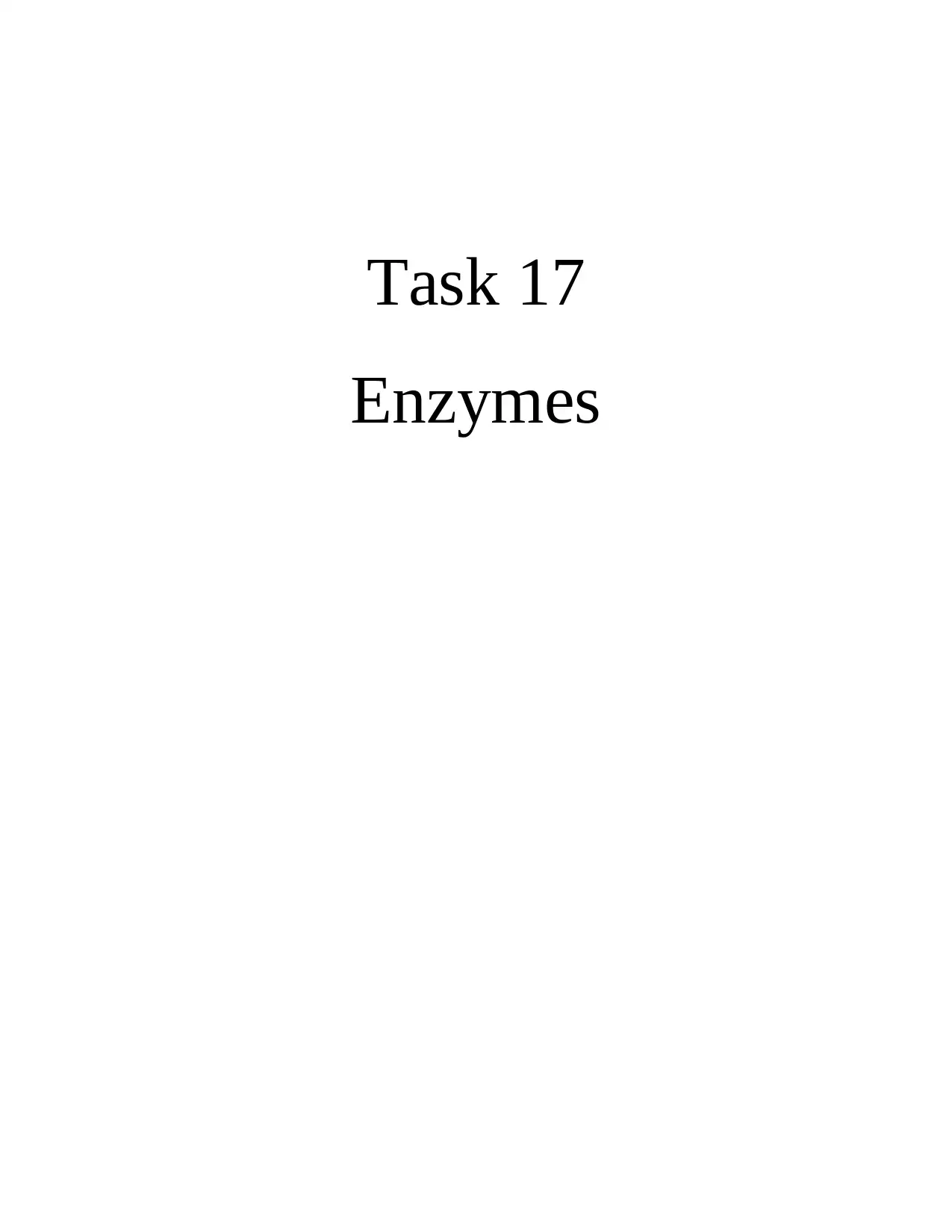
Task 17
Enzymes
Enzymes
Secure Best Marks with AI Grader
Need help grading? Try our AI Grader for instant feedback on your assignments.
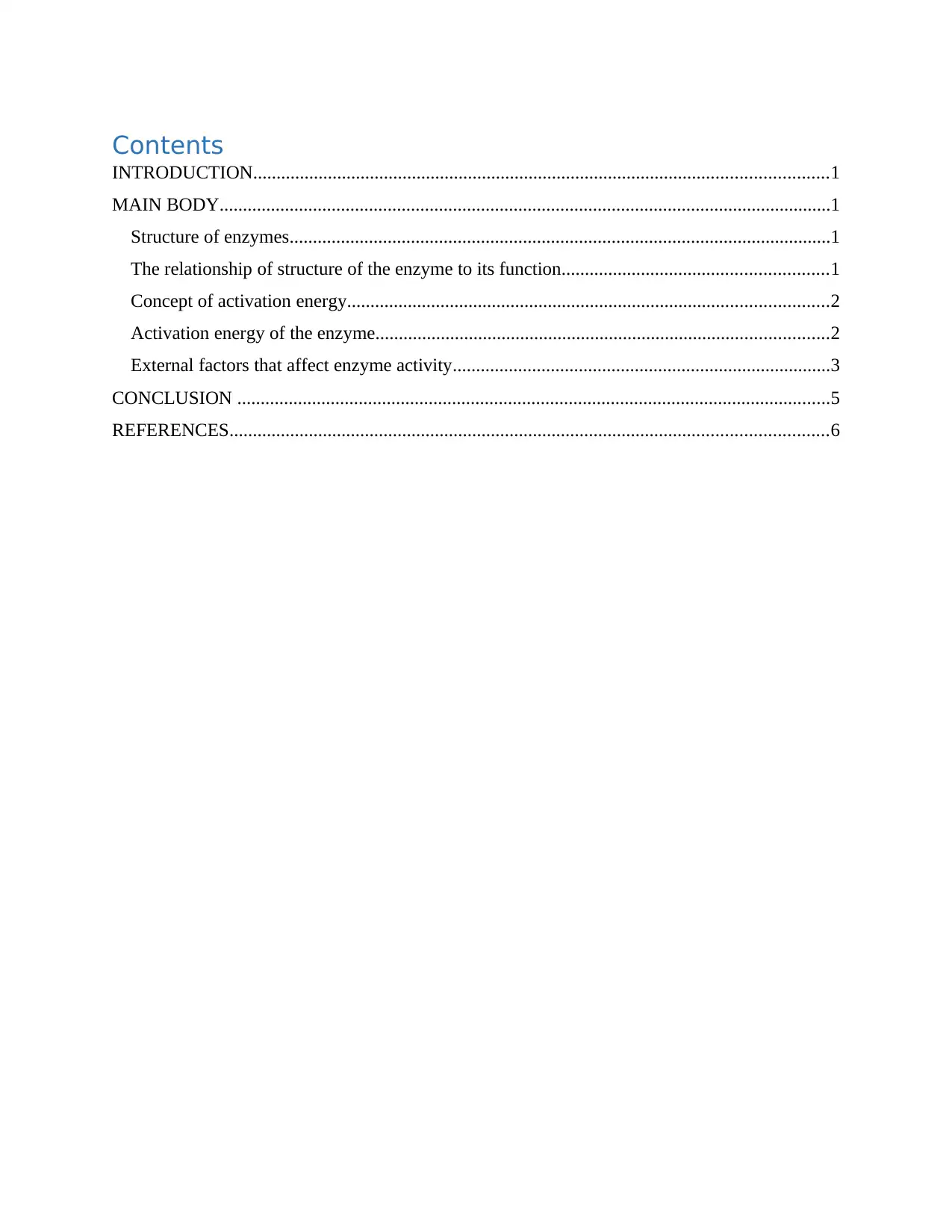
Contents
INTRODUCTION...........................................................................................................................1
MAIN BODY...................................................................................................................................1
Structure of enzymes....................................................................................................................1
The relationship of structure of the enzyme to its function.........................................................1
Concept of activation energy.......................................................................................................2
Activation energy of the enzyme.................................................................................................2
External factors that affect enzyme activity.................................................................................3
CONCLUSION ...............................................................................................................................5
REFERENCES................................................................................................................................6
INTRODUCTION...........................................................................................................................1
MAIN BODY...................................................................................................................................1
Structure of enzymes....................................................................................................................1
The relationship of structure of the enzyme to its function.........................................................1
Concept of activation energy.......................................................................................................2
Activation energy of the enzyme.................................................................................................2
External factors that affect enzyme activity.................................................................................3
CONCLUSION ...............................................................................................................................5
REFERENCES................................................................................................................................6

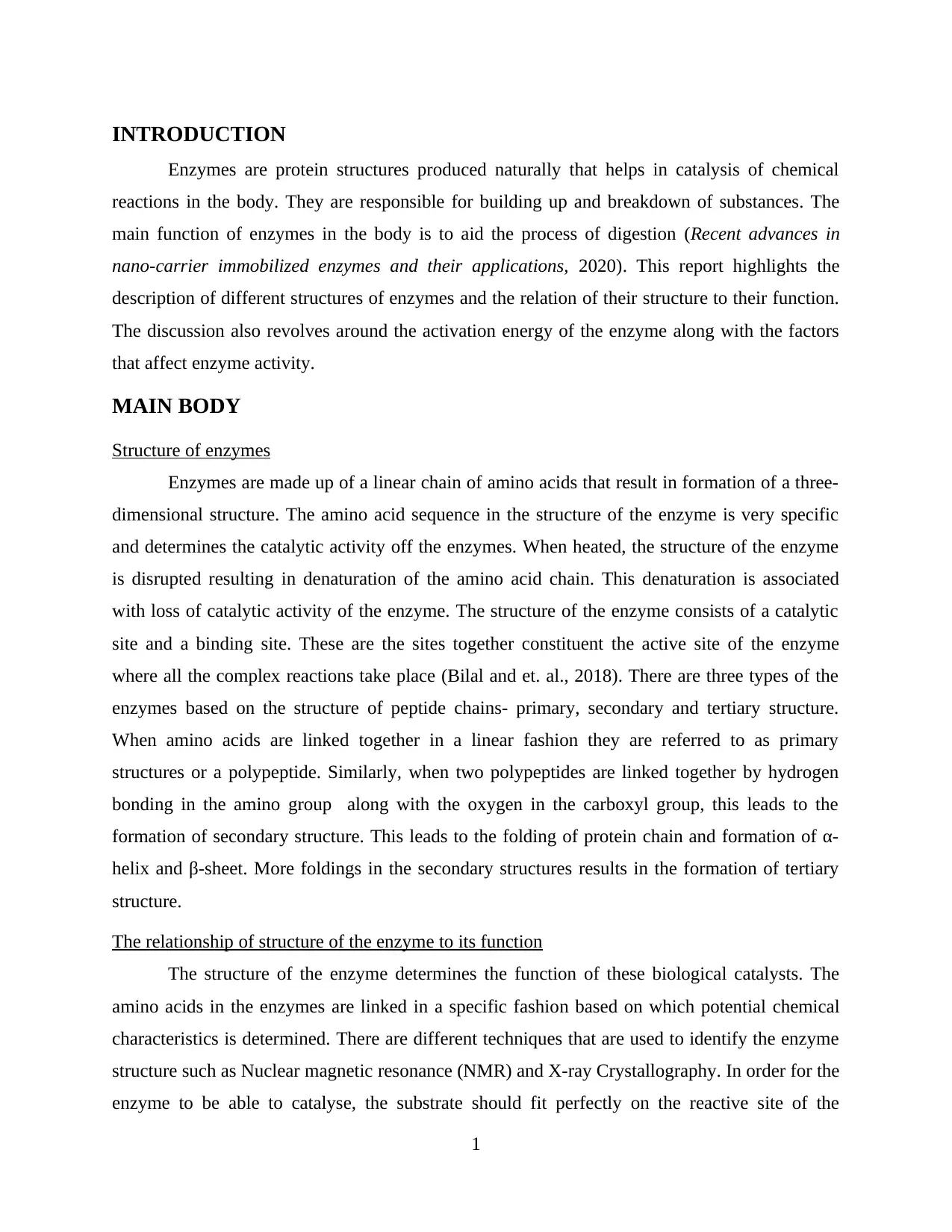
INTRODUCTION
Enzymes are protein structures produced naturally that helps in catalysis of chemical
reactions in the body. They are responsible for building up and breakdown of substances. The
main function of enzymes in the body is to aid the process of digestion (Recent advances in
nano-carrier immobilized enzymes and their applications, 2020). This report highlights the
description of different structures of enzymes and the relation of their structure to their function.
The discussion also revolves around the activation energy of the enzyme along with the factors
that affect enzyme activity.
MAIN BODY
Structure of enzymes
Enzymes are made up of a linear chain of amino acids that result in formation of a three-
dimensional structure. The amino acid sequence in the structure of the enzyme is very specific
and determines the catalytic activity off the enzymes. When heated, the structure of the enzyme
is disrupted resulting in denaturation of the amino acid chain. This denaturation is associated
with loss of catalytic activity of the enzyme. The structure of the enzyme consists of a catalytic
site and a binding site. These are the sites together constituent the active site of the enzyme
where all the complex reactions take place (Bilal and et. al., 2018). There are three types of the
enzymes based on the structure of peptide chains- primary, secondary and tertiary structure.
When amino acids are linked together in a linear fashion they are referred to as primary
structures or a polypeptide. Similarly, when two polypeptides are linked together by hydrogen
bonding in the amino group along with the oxygen in the carboxyl group, this leads to the
formation of secondary structure. This leads to the folding of protein chain and formation of α-
helix and β-sheet. More foldings in the secondary structures results in the formation of tertiary
structure.
The relationship of structure of the enzyme to its function
The structure of the enzyme determines the function of these biological catalysts. The
amino acids in the enzymes are linked in a specific fashion based on which potential chemical
characteristics is determined. There are different techniques that are used to identify the enzyme
structure such as Nuclear magnetic resonance (NMR) and X-ray Crystallography. In order for the
enzyme to be able to catalyse, the substrate should fit perfectly on the reactive site of the
1
Enzymes are protein structures produced naturally that helps in catalysis of chemical
reactions in the body. They are responsible for building up and breakdown of substances. The
main function of enzymes in the body is to aid the process of digestion (Recent advances in
nano-carrier immobilized enzymes and their applications, 2020). This report highlights the
description of different structures of enzymes and the relation of their structure to their function.
The discussion also revolves around the activation energy of the enzyme along with the factors
that affect enzyme activity.
MAIN BODY
Structure of enzymes
Enzymes are made up of a linear chain of amino acids that result in formation of a three-
dimensional structure. The amino acid sequence in the structure of the enzyme is very specific
and determines the catalytic activity off the enzymes. When heated, the structure of the enzyme
is disrupted resulting in denaturation of the amino acid chain. This denaturation is associated
with loss of catalytic activity of the enzyme. The structure of the enzyme consists of a catalytic
site and a binding site. These are the sites together constituent the active site of the enzyme
where all the complex reactions take place (Bilal and et. al., 2018). There are three types of the
enzymes based on the structure of peptide chains- primary, secondary and tertiary structure.
When amino acids are linked together in a linear fashion they are referred to as primary
structures or a polypeptide. Similarly, when two polypeptides are linked together by hydrogen
bonding in the amino group along with the oxygen in the carboxyl group, this leads to the
formation of secondary structure. This leads to the folding of protein chain and formation of α-
helix and β-sheet. More foldings in the secondary structures results in the formation of tertiary
structure.
The relationship of structure of the enzyme to its function
The structure of the enzyme determines the function of these biological catalysts. The
amino acids in the enzymes are linked in a specific fashion based on which potential chemical
characteristics is determined. There are different techniques that are used to identify the enzyme
structure such as Nuclear magnetic resonance (NMR) and X-ray Crystallography. In order for the
enzyme to be able to catalyse, the substrate should fit perfectly on the reactive site of the
1
Secure Best Marks with AI Grader
Need help grading? Try our AI Grader for instant feedback on your assignments.
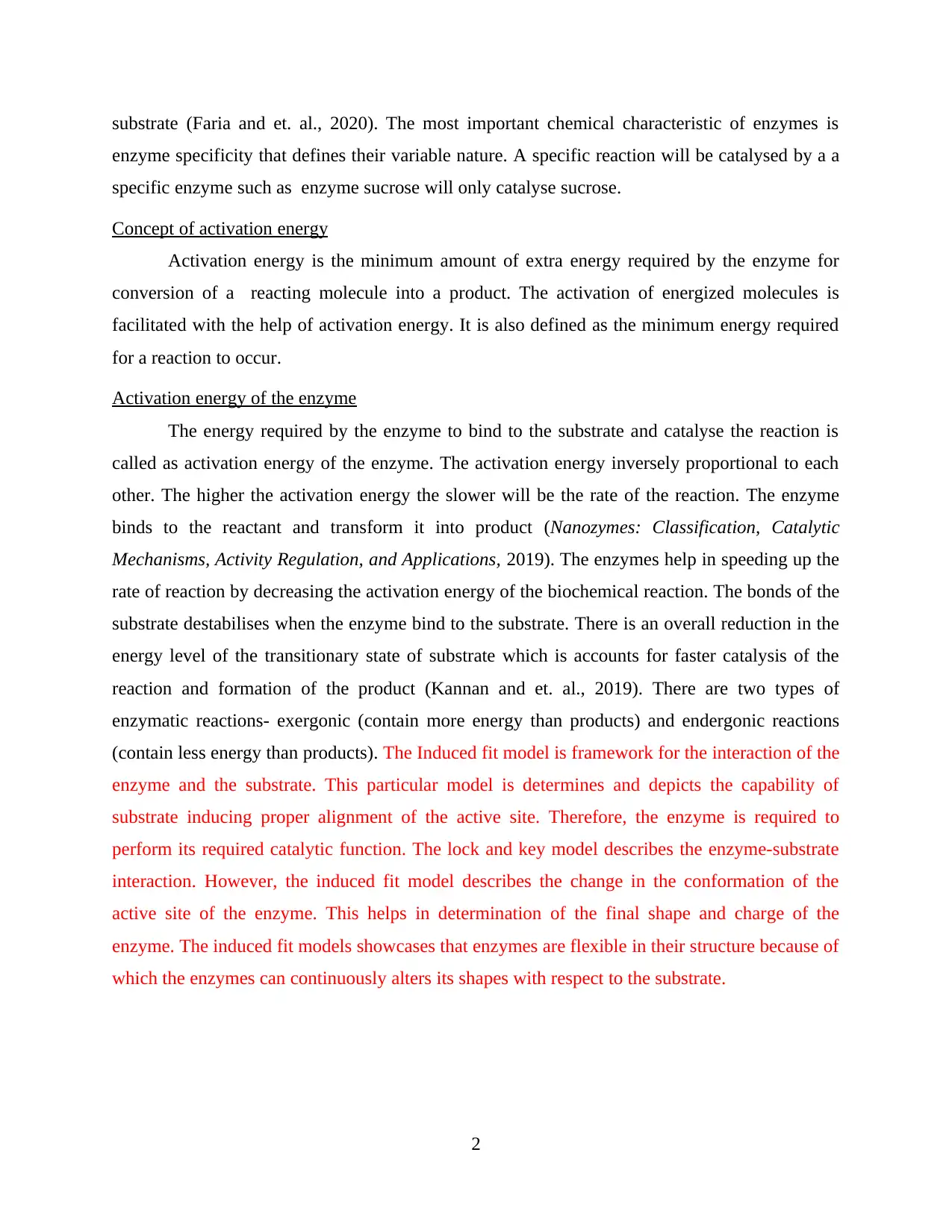
substrate (Faria and et. al., 2020). The most important chemical characteristic of enzymes is
enzyme specificity that defines their variable nature. A specific reaction will be catalysed by a a
specific enzyme such as enzyme sucrose will only catalyse sucrose.
Concept of activation energy
Activation energy is the minimum amount of extra energy required by the enzyme for
conversion of a reacting molecule into a product. The activation of energized molecules is
facilitated with the help of activation energy. It is also defined as the minimum energy required
for a reaction to occur.
Activation energy of the enzyme
The energy required by the enzyme to bind to the substrate and catalyse the reaction is
called as activation energy of the enzyme. The activation energy inversely proportional to each
other. The higher the activation energy the slower will be the rate of the reaction. The enzyme
binds to the reactant and transform it into product (Nanozymes: Classification, Catalytic
Mechanisms, Activity Regulation, and Applications, 2019). The enzymes help in speeding up the
rate of reaction by decreasing the activation energy of the biochemical reaction. The bonds of the
substrate destabilises when the enzyme bind to the substrate. There is an overall reduction in the
energy level of the transitionary state of substrate which is accounts for faster catalysis of the
reaction and formation of the product (Kannan and et. al., 2019). There are two types of
enzymatic reactions- exergonic (contain more energy than products) and endergonic reactions
(contain less energy than products). The Induced fit model is framework for the interaction of the
enzyme and the substrate. This particular model is determines and depicts the capability of
substrate inducing proper alignment of the active site. Therefore, the enzyme is required to
perform its required catalytic function. The lock and key model describes the enzyme-substrate
interaction. However, the induced fit model describes the change in the conformation of the
active site of the enzyme. This helps in determination of the final shape and charge of the
enzyme. The induced fit models showcases that enzymes are flexible in their structure because of
which the enzymes can continuously alters its shapes with respect to the substrate.
2
enzyme specificity that defines their variable nature. A specific reaction will be catalysed by a a
specific enzyme such as enzyme sucrose will only catalyse sucrose.
Concept of activation energy
Activation energy is the minimum amount of extra energy required by the enzyme for
conversion of a reacting molecule into a product. The activation of energized molecules is
facilitated with the help of activation energy. It is also defined as the minimum energy required
for a reaction to occur.
Activation energy of the enzyme
The energy required by the enzyme to bind to the substrate and catalyse the reaction is
called as activation energy of the enzyme. The activation energy inversely proportional to each
other. The higher the activation energy the slower will be the rate of the reaction. The enzyme
binds to the reactant and transform it into product (Nanozymes: Classification, Catalytic
Mechanisms, Activity Regulation, and Applications, 2019). The enzymes help in speeding up the
rate of reaction by decreasing the activation energy of the biochemical reaction. The bonds of the
substrate destabilises when the enzyme bind to the substrate. There is an overall reduction in the
energy level of the transitionary state of substrate which is accounts for faster catalysis of the
reaction and formation of the product (Kannan and et. al., 2019). There are two types of
enzymatic reactions- exergonic (contain more energy than products) and endergonic reactions
(contain less energy than products). The Induced fit model is framework for the interaction of the
enzyme and the substrate. This particular model is determines and depicts the capability of
substrate inducing proper alignment of the active site. Therefore, the enzyme is required to
perform its required catalytic function. The lock and key model describes the enzyme-substrate
interaction. However, the induced fit model describes the change in the conformation of the
active site of the enzyme. This helps in determination of the final shape and charge of the
enzyme. The induced fit models showcases that enzymes are flexible in their structure because of
which the enzymes can continuously alters its shapes with respect to the substrate.
2

Source: https://www.shmoop.com/study-guides/biology/energy-flow-enzymes/enzymes
The mechanism used to explain the enzymatic action is referred to as lock and key
mechanism. This lock and key mechanism defines the specificity of the active site of the enzyme
(Modifying bio-catalytic properties of enzymes for efficient biocatalysis: a review from
immobilization strategies viewpoint, 2018). This implies that only a certain substrate can fit in
the active site of the enzyme. This property of enzyme make it extremely specific. After the
substrate binds to the specific active site of the enzyme, there is formation of enzyme substrate
complex. This stage is followed by catalysis of reaction where the product complex is formed
and released (Modarres and Taghavizadeh Yazdi, 2021). The product is then released from the
active site and the enzyme can be reused again for catalyse more reactions.
External factors that affect enzyme activity
Enzymes are known to work at a specific temperature and ranges of pH. The activity of
enzyme is affected by a variety of factors which can alter the ability of the enzyme to bind to the
substrate. Some of the factors are given below:
Temperature: Enzymes can get denatured and halt their working when exposed to high
temperatures (RNA-modifying enzymes and their function in a chromatin context, 2019).
However, rising temperatures helps in speeding up the reaction whereas extremely low
temperatures can slow down the process of catalysis of substrate.
3
Illustration 1: Activation energy vs progress of
reaction
The mechanism used to explain the enzymatic action is referred to as lock and key
mechanism. This lock and key mechanism defines the specificity of the active site of the enzyme
(Modifying bio-catalytic properties of enzymes for efficient biocatalysis: a review from
immobilization strategies viewpoint, 2018). This implies that only a certain substrate can fit in
the active site of the enzyme. This property of enzyme make it extremely specific. After the
substrate binds to the specific active site of the enzyme, there is formation of enzyme substrate
complex. This stage is followed by catalysis of reaction where the product complex is formed
and released (Modarres and Taghavizadeh Yazdi, 2021). The product is then released from the
active site and the enzyme can be reused again for catalyse more reactions.
External factors that affect enzyme activity
Enzymes are known to work at a specific temperature and ranges of pH. The activity of
enzyme is affected by a variety of factors which can alter the ability of the enzyme to bind to the
substrate. Some of the factors are given below:
Temperature: Enzymes can get denatured and halt their working when exposed to high
temperatures (RNA-modifying enzymes and their function in a chromatin context, 2019).
However, rising temperatures helps in speeding up the reaction whereas extremely low
temperatures can slow down the process of catalysis of substrate.
3
Illustration 1: Activation energy vs progress of
reaction
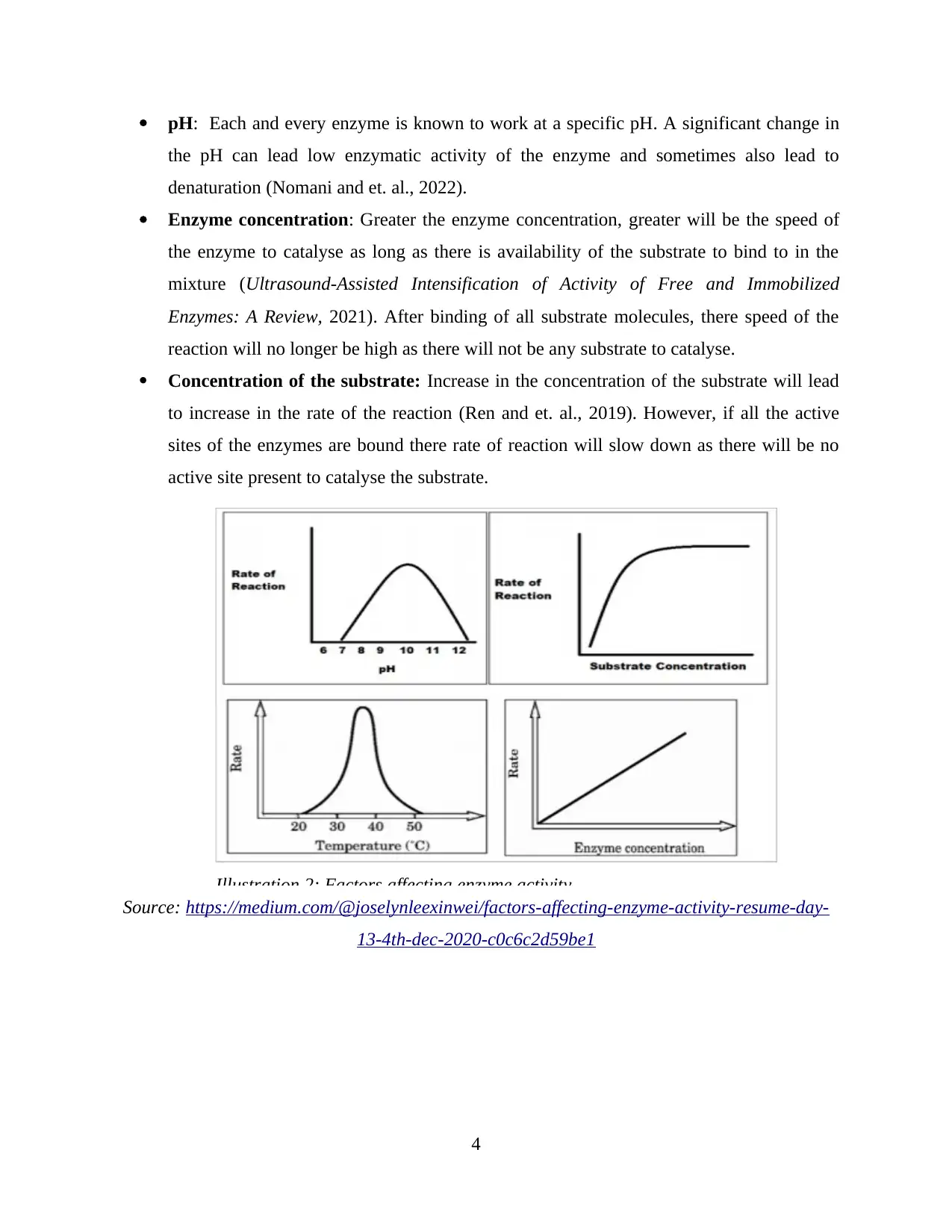
pH: Each and every enzyme is known to work at a specific pH. A significant change in
the pH can lead low enzymatic activity of the enzyme and sometimes also lead to
denaturation (Nomani and et. al., 2022).
Enzyme concentration: Greater the enzyme concentration, greater will be the speed of
the enzyme to catalyse as long as there is availability of the substrate to bind to in the
mixture (Ultrasound-Assisted Intensification of Activity of Free and Immobilized
Enzymes: A Review, 2021). After binding of all substrate molecules, there speed of the
reaction will no longer be high as there will not be any substrate to catalyse.
Concentration of the substrate: Increase in the concentration of the substrate will lead
to increase in the rate of the reaction (Ren and et. al., 2019). However, if all the active
sites of the enzymes are bound there rate of reaction will slow down as there will be no
active site present to catalyse the substrate.
Source: https://medium.com/@joselynleexinwei/factors-affecting-enzyme-activity-resume-day-
13-4th-dec-2020-c0c6c2d59be1
4
Illustration 2: Factors affecting enzyme activity
the pH can lead low enzymatic activity of the enzyme and sometimes also lead to
denaturation (Nomani and et. al., 2022).
Enzyme concentration: Greater the enzyme concentration, greater will be the speed of
the enzyme to catalyse as long as there is availability of the substrate to bind to in the
mixture (Ultrasound-Assisted Intensification of Activity of Free and Immobilized
Enzymes: A Review, 2021). After binding of all substrate molecules, there speed of the
reaction will no longer be high as there will not be any substrate to catalyse.
Concentration of the substrate: Increase in the concentration of the substrate will lead
to increase in the rate of the reaction (Ren and et. al., 2019). However, if all the active
sites of the enzymes are bound there rate of reaction will slow down as there will be no
active site present to catalyse the substrate.
Source: https://medium.com/@joselynleexinwei/factors-affecting-enzyme-activity-resume-day-
13-4th-dec-2020-c0c6c2d59be1
4
Illustration 2: Factors affecting enzyme activity
Paraphrase This Document
Need a fresh take? Get an instant paraphrase of this document with our AI Paraphraser

CONCLUSION
From the above report it can be concluded that enzymes are proteins that speed up
chemical processes in the body. These reactions are employed in the formation of energy along
with breaking and building of constituents in the body. These structural proteins bind to different
molecules and alter them in unique ways. Enzymes play a vital role in respiration, digestion and
functioning of muscle and nerve. There are various factors that affect the activity of enzymes
which explains their specific nature.
5
From the above report it can be concluded that enzymes are proteins that speed up
chemical processes in the body. These reactions are employed in the formation of energy along
with breaking and building of constituents in the body. These structural proteins bind to different
molecules and alter them in unique ways. Enzymes play a vital role in respiration, digestion and
functioning of muscle and nerve. There are various factors that affect the activity of enzymes
which explains their specific nature.
5
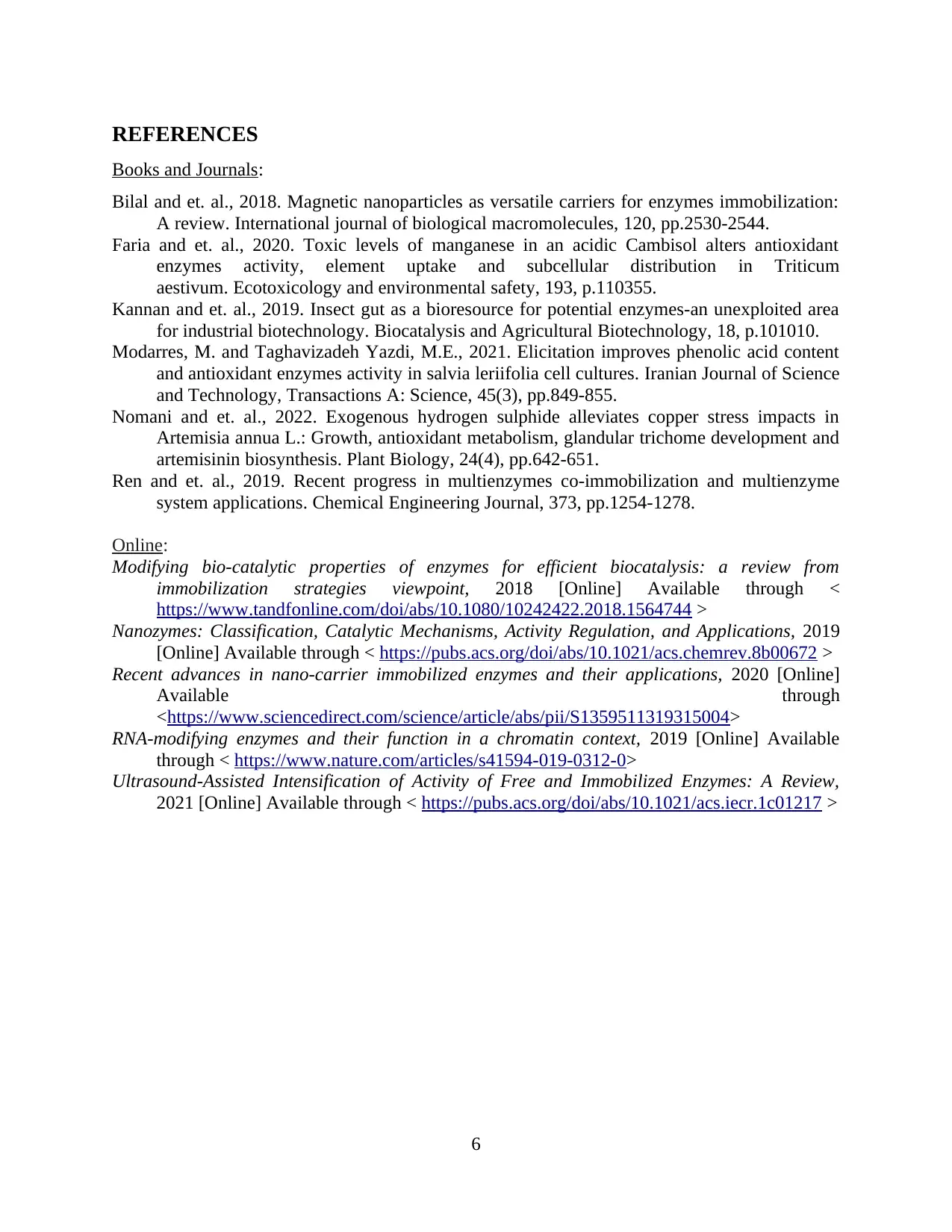
REFERENCES
Books and Journals:
Bilal and et. al., 2018. Magnetic nanoparticles as versatile carriers for enzymes immobilization:
A review. International journal of biological macromolecules, 120, pp.2530-2544.
Faria and et. al., 2020. Toxic levels of manganese in an acidic Cambisol alters antioxidant
enzymes activity, element uptake and subcellular distribution in Triticum
aestivum. Ecotoxicology and environmental safety, 193, p.110355.
Kannan and et. al., 2019. Insect gut as a bioresource for potential enzymes-an unexploited area
for industrial biotechnology. Biocatalysis and Agricultural Biotechnology, 18, p.101010.
Modarres, M. and Taghavizadeh Yazdi, M.E., 2021. Elicitation improves phenolic acid content
and antioxidant enzymes activity in salvia leriifolia cell cultures. Iranian Journal of Science
and Technology, Transactions A: Science, 45(3), pp.849-855.
Nomani and et. al., 2022. Exogenous hydrogen sulphide alleviates copper stress impacts in
Artemisia annua L.: Growth, antioxidant metabolism, glandular trichome development and
artemisinin biosynthesis. Plant Biology, 24(4), pp.642-651.
Ren and et. al., 2019. Recent progress in multienzymes co-immobilization and multienzyme
system applications. Chemical Engineering Journal, 373, pp.1254-1278.
Online:
Modifying bio-catalytic properties of enzymes for efficient biocatalysis: a review from
immobilization strategies viewpoint, 2018 [Online] Available through <
https://www.tandfonline.com/doi/abs/10.1080/10242422.2018.1564744 >
Nanozymes: Classification, Catalytic Mechanisms, Activity Regulation, and Applications, 2019
[Online] Available through < https://pubs.acs.org/doi/abs/10.1021/acs.chemrev.8b00672 >
Recent advances in nano-carrier immobilized enzymes and their applications, 2020 [Online]
Available through
<https://www.sciencedirect.com/science/article/abs/pii/S1359511319315004>
RNA-modifying enzymes and their function in a chromatin context, 2019 [Online] Available
through < https://www.nature.com/articles/s41594-019-0312-0>
Ultrasound-Assisted Intensification of Activity of Free and Immobilized Enzymes: A Review,
2021 [Online] Available through < https://pubs.acs.org/doi/abs/10.1021/acs.iecr.1c01217 >
6
Books and Journals:
Bilal and et. al., 2018. Magnetic nanoparticles as versatile carriers for enzymes immobilization:
A review. International journal of biological macromolecules, 120, pp.2530-2544.
Faria and et. al., 2020. Toxic levels of manganese in an acidic Cambisol alters antioxidant
enzymes activity, element uptake and subcellular distribution in Triticum
aestivum. Ecotoxicology and environmental safety, 193, p.110355.
Kannan and et. al., 2019. Insect gut as a bioresource for potential enzymes-an unexploited area
for industrial biotechnology. Biocatalysis and Agricultural Biotechnology, 18, p.101010.
Modarres, M. and Taghavizadeh Yazdi, M.E., 2021. Elicitation improves phenolic acid content
and antioxidant enzymes activity in salvia leriifolia cell cultures. Iranian Journal of Science
and Technology, Transactions A: Science, 45(3), pp.849-855.
Nomani and et. al., 2022. Exogenous hydrogen sulphide alleviates copper stress impacts in
Artemisia annua L.: Growth, antioxidant metabolism, glandular trichome development and
artemisinin biosynthesis. Plant Biology, 24(4), pp.642-651.
Ren and et. al., 2019. Recent progress in multienzymes co-immobilization and multienzyme
system applications. Chemical Engineering Journal, 373, pp.1254-1278.
Online:
Modifying bio-catalytic properties of enzymes for efficient biocatalysis: a review from
immobilization strategies viewpoint, 2018 [Online] Available through <
https://www.tandfonline.com/doi/abs/10.1080/10242422.2018.1564744 >
Nanozymes: Classification, Catalytic Mechanisms, Activity Regulation, and Applications, 2019
[Online] Available through < https://pubs.acs.org/doi/abs/10.1021/acs.chemrev.8b00672 >
Recent advances in nano-carrier immobilized enzymes and their applications, 2020 [Online]
Available through
<https://www.sciencedirect.com/science/article/abs/pii/S1359511319315004>
RNA-modifying enzymes and their function in a chromatin context, 2019 [Online] Available
through < https://www.nature.com/articles/s41594-019-0312-0>
Ultrasound-Assisted Intensification of Activity of Free and Immobilized Enzymes: A Review,
2021 [Online] Available through < https://pubs.acs.org/doi/abs/10.1021/acs.iecr.1c01217 >
6
1 out of 9
Related Documents
Your All-in-One AI-Powered Toolkit for Academic Success.
+13062052269
info@desklib.com
Available 24*7 on WhatsApp / Email
![[object Object]](/_next/static/media/star-bottom.7253800d.svg)
Unlock your academic potential
© 2024 | Zucol Services PVT LTD | All rights reserved.





